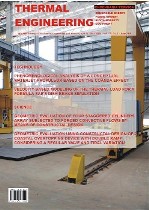CONSTRUCTAL DESIGN OF FINS IN COOLED CAVITIES BY NON-NEWTONIAN FLUIDS
DOI:
https://doi.org/10.5380/reterm.v18i1.67055Keywords:
fins, mixed convection, non-Newtonian fluids, computational fluid dynamics, Constructal DesignAbstract
The present work investigates the Construtal Design of fins inserted in cavities submitted to mixed convection by non-Newtonian fluids. The objective is to obtain the optimum aspect ratio for the fin considering different flow conditions and variations in the rheological parameters of the fluid. The phenomena of flow and heat transfer are modeled by mass balance, momentum and energy equations, and by the generalized Newtonian liquid constitutive equation. The viscosity is modeled as that of a pseudoplastic fluid, using the Carreau function. The optimization problem consists in maximizing heat transfer from the fin using the average Nusselt number. The investigated project variable is the aspect ratio between the edges of the rectangular plane fin profile. The restrictions are the volume of the cavity and the fin. The results are obtained numerically using a finite volume code and a two-dimensional geometry, through exhaustive searching. The results show that the fin geometry influences the maximum Nusselt number mainly for the cases with high Reynolds and Rayleigh numbers, such as was shown in previous studies. The results show that the fin geometry influences the maximum Nusselt number mainly for the cases with high Reynolds and Rayleigh numbers, as was shown in previous studies. It was also found that the Nusselt number increases as the increase in flow intensity, represented by the parameter p, and that the result of the maximum Nusselt number does not change monotonically with the non-Newtonian dimensionless viscosity and with the flow index, showing that the pseudoplasticity of the fluid implies optimal configurations very different from those predicted for Newtonian fluids.
Downloads
Published
How to Cite
Issue
Section
License
Direitos Autorais para artigos publicados nesta revista são do autor, com direitos de primeira publicação para a revista. Em virtude da aparecerem nesta revista de acesso público, os artigos são de uso gratuito, com atribuições próprias, em aplicações educacionais e não-comerciais.



